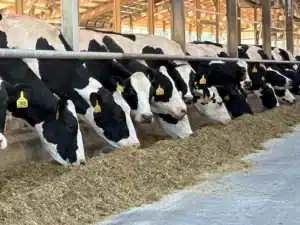Ag-Bagging your forages provides dairy and beef operations many benefits including higher forage quality, limiting forage loss, segregating forages and unlimited feed storage. In this three-part series, these benefits will be evaluated and discussed. In this article, we will be discussing how Ag-Bagging creates the best storage environment for high quality forage.
By storing your forage in an oxygen-free plastic bag, this is the gold standard in forage storage quality. Ag-Bagging results in a faster forage fermentation cycle, stabilizing your forage nutrients and moisture with lower pH due to lactic acid from optimized fermentation. Also, your forage is immediately protected from the elements. Whether it means moisture loss from evaporation or increased moisture from a summer storm, your forage is protected.
“Anyone who is in the feed business knows that forage bags are the closest thing to fermenting in an oxygen free environment. The best forage fermentation happens in bags. You can make the most of your forages by bagging,” says Gerrit DeBruin, owner of Prescription Premix, an independent nutrition consulting business based in Lake Mills, WI.
With Ag-Bagging, your forage quality is much higher than a drive over pile. Your forage has much less waste and shrink estimated to be anywhere between 10-30% compared to piling your forage. And that dry matter loss isn’t just from storage. When feeding out, forage bags have a smaller open face and less heating material compared to the entire open face of a drive-over pile. Higher temps mean higher dry matter losses. Keep your forages cool in an Ag-Bag and maintain that dry matter and quality that you worked so hard to produce and harvest.
Alfalfa input costs have risen over the years with increasing technology seed costs, fertilizer, machinery and diesel prices. Plus, insecticide spray frequency and costs have risen too. Your alfalfa forage is more valuable to your bottom line than ever before.
“When I run forage calculations, we have seen that the average cost of home raised alfalfa is two times more expensive than corn silage repeatedly. It amplifies the importance of getting your alfalfa crop put up in the most ideal conditions. Bagging is your friend, “stated DeBruin.
The other challenge to forage quality is the alfalfa harvest window. With each new season, the main goal is to harvest the alfalfa in its peak condition without rain. The new T-Series Ag-Baggers have been designed to make Ag-Bagging easier, faster and more efficient. The Ag-Baggers feature wider conveyors, a new rotor design for higher density, and higher capacity. In addition, Ag-Bagging can extend your harvest window by allowing a forage grower to start forage harvesting at higher moisture levels, and keep harvesting right up to that impending rainstorm, so you can get more in the bag compared to having to stop to cover a pile before the rain comes.
According to DeBruin, “By bagging your forages, you have a dramatically wider harvesting window in alfalfa. I have seen the most unbelievable ranges in moisture. By bagging these forages, you can harvest at a higher moisture level. I have seen really wet alfalfa forage go into a bag. That forage fermented beautifully and fed out beautifully. With more flexibility in your harvesting window, that is a big, big deal on a dairy.”
Ag-Bag dairy customers have consistently praised Ag-Baggers for their high-quality forage resulting in high milk production. Schraufnagel Farms, located in Lomira, WI, milk 120-cows with Lely robots. Their herd averages 109 lbs of milk with 3.8 lbs fat and 3.1 lbs protein with 2.4 times a day milking. Schraufnagel Dairy has been Ag-Bagging their forages for over 35-years.
“High quality forage is why our cows are milking as well as they do. We strive to keep our forage quality as high as possible and keep a consistent forage quality. With crop inputs as high as they are, bagging our forage helps us keep high quality forage. When you put good quality forage in, then you have good quality forage coming out. And with better quality forage, the better the cows will milk,” shared Aaron Schraufnagel, co-owner of Schraufnagel Farms.
Schraufnagel Dairy shared that their dairy nutritionist compliments them regarding their high quality forage. “By bagging our forage, we have been fermenting excellent feed. In fact, our nutritionists told us we had our best corn silage yet. We have the best quality and very digestible corn silage than ever before. This year, it tested out at 4,000 lbs of milk per ton,” said Andy Schraufnagel III, co-owner of Schraufnagel Farms.
Andy also shared, “When it rains, we don’t need to stop and run to cover a bunker or worry that the rain won’t be too bad, and it won’t soak into the forage too much. It also gives us more flexibility with our harvest times, since we can keep harvesting right up until the rain, unload the load into the Ag-Bagger and then turn off the machine and wait until the rain stops.”
With Ag-Bagging, your valuable forage is immediately protected and beings to ferment quickly. Ag-Bagging means a wider harvest window to harvest your forage in its peak condition. By having high quality forage, this results in more milk per cow. Plus, Genuine Ag-Bags are manufactured in the USA with virgin plastic resin, and they come with a 2-year warranty. Better forage means better storage by using Ag-Bag.

